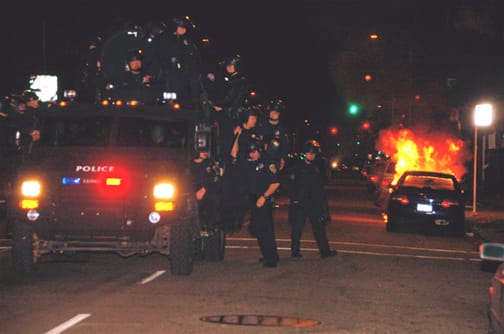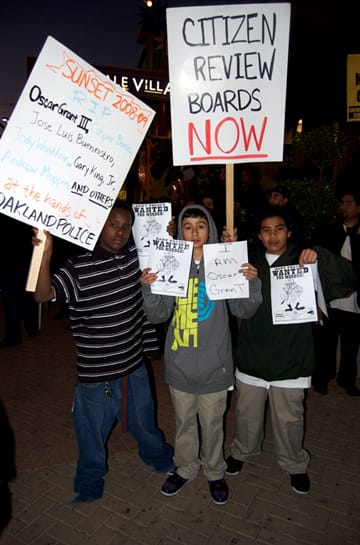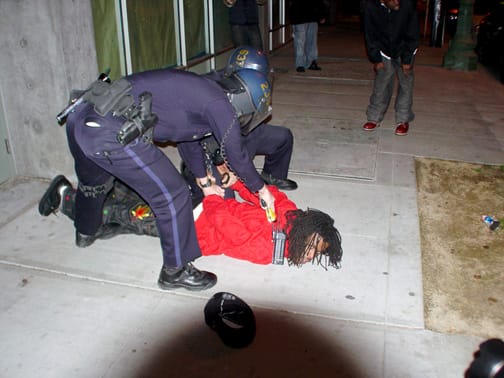 Only when Oakland’s rage over the execution of Oscar Grant broke out into a full rebellion on Wednesday, Jan. 7, did authorities, after nearly a week of silence, take this police murder seriously. Still, Oakland youth took the brunt as police used military equipment such as this tank-like hummer to put down the rebellion – while Mayor Ron Dellums promised police restraint. – Photo: Brooke Anderson, IndyBay |
Oakland rebellion: Eyewitness report
|
Special to TheBlackHour.com
During the first Wednesday of 2009, downtown Oakland was physically rocked by the justified fury that the rebellions brought out in response to the police killing of 22-year-old unarmed Black male Oscar Grant, who was fatally shot at the Fruitvale BART station while he was face down, being restrained by two officers, in front of dozens of witnesses New Year’s morning.
For me, that day of protesting started at the Fruitvale BART station with a peaceful rally that was organized by members of the Bay Area’s activist community. Speakers included Crea Gomez, a community non-profit advocate, local rappers like Zion of Zion I and Mistah FAB, as well as concerned community members like myself who were appalled at the police murder. I was there as a member of the Black community demanding justice for the police murder of Oscar Grant, as well as I was in attendance as a journalist on assignment.
When I arrived a little bit after the protest started, I witnessed at least 200-300 people who were demanding justice for Oscar Grant’s family at the BART station. BART had shut down the station so that it would slow the pace of protesters who could have used the BART to get to the rally but had to rely on Oakland’s slow ass bus system to make their voices heard. People of all nationalities, ages, classes and religions were chanting angry slogans led by the speakers: “Fuck the police!” “No justice, no peace!” “Justice for Oscar Grant!”
One of the things that struck me most about this rally was the fact that it was so many people who were moved to protest in East Oakland, which is rare during a workday. The question that I asked on the microphone when it was my turn to speak was, “Why didn’t people come out when Bay Area police officers murdered unarmed Terrence Mearis, unarmed Casper Banjo, unarmed Anita Gaye, unarmed Gary King, unarmed Gus Rugley, unarmed Cammerin Boyd, unarmed Idriss Stelley or when the police terrorized 15-year-old unarmed Laronte Studesville, unarmed Randy Murphy or unarmed Nadra Foster? Is it because these cases were not caught on camera?”
 These children, a racial cross-section of Oakland, seem determined to stop the police’ open season on young men of color before it’s their turn. The sign on the left reads, “Sunset 2008-90 RIP Oscar Grant III, Casper Banjo, Jose Luis Buenrostro, Jody Woodfox, Gary King Jr., Andrew Moppin and others at the hands of Oakland police.” Photo: Demondre Ward |
It seemed to me that people have to see police atrocities on television to believe that they happen in the Black community, when young Black males in the Bay Area and all over the country know from experience that the police have a legal license to kill you, severely beat you or frame you with no repercussions. An example of this is the Oscar Grant case, where he was unarmed and shot point blank, while being restrained by two officers and surrounded by at least three more, yet no one was charged with murder, manslaughter or as an accessory to murder. After a few hours, this demonstration ended peacefully, with the remaining protesters marching to downtown Oakland.
I left and went and hung out with some of my friends that were at the Fruitvale BART protest. About an hour later, I got a call telling me that I needed to cover what was going on in the streets of downtown. When I got there, I saw dozens of police in a huge circle on 14th and Broadway, occupying the intersection in front of City Hall. The Oakland hummer, the tank-like armored vehicle that was shown on the news, had just shown up.
On one block, the militant activists were shouting slogans face to face with police. Behind them, a few bands broken up into racial groups were smashing car windshields and storefronts on 14th, using their feet and their skateboards. Many of the white protesters, who had their faces covered up, were involved in setting cars on fire. I was photographing this historic time, where the people’s patience ran short on city officials, including the mayor, who refused to indict any of the officers involved.
Since this day, I have seen many reports talking about white invaders taking over the rebellion, which is b.s. Yes, they played a part, but so did everyone else. They didn’t take over anything, and the Black, Brown and Asian youth involved were taking leadership from themselves, not the white people.
I’ve also heard some criticisms of the rebels, because of the fact that they tore up innocent people’s property. But the reality is that the peaceful protest outside of Fruitvale BART as well as the meeting of ministers, reverends and local politicians that took place that morning demanding an explanation from the D.A. did not put the mayor, police and city officials on notice nor did those actions have the energy behind them to make the police execution of Oscar Grant a national story.
The rebellion did. As a matter of fact, during the rebellion, Mayor Dellums had a secret meeting with many of these suit-types, then proceeded to walk through the rebellion like Black Jesus, with about 50 primarily Black people in suits following him across Broadway to City Hall, where he held a press conference. Needless to say, the protesters he was talking to demanded that he indict all of the officers involved, but the mayor clouded the issue with words like “respect” and “civility” while the city was burning and being trashed in the backdrop due to his negligence in dealing with a police force that has a notorious history of terrorism in the Black community - as if it had not been police who shot an unarmed Black man, Oscar Grant, a week prior
Once the mayor was booed and run off from his press conference, Round 2 of the rebellion began, claiming Broadway and 17th. This was at about 9 p.m. The Oakland police escalated their attacks on protesters by six or seven of them at one time breaking ranks from the other dozens of officers they were originally standing with to tackle and arrest anyone in the vicinity. Another tactic utilized by the OPD was to roll up to an intersection in a hummer with about 10 pigs hanging off of it, and the cops would jump off, brutally arresting everyone in reach.
I was arrested in front of the Ron Dellums Federal Building, after at least two officers broke out running after me for no reason, tackled me to the cement, injuring my left leg, and bouncing my camera off of the ground. I was charged with the trumped up charge of felony arson. Luckily, a few legal observers from the National Lawyers Guild saw the whole episode.
After I was arrested and in the paddy wagon, I heard a dispatcher say that the police needed to confiscate all cameras and camera phones from arrestees, which they did, so that they could use this info as evidence in different cases. To add to their reasoning, they also wanted to cover up and slow down the amount of information that could be posted, broadcast and published that was live from the street rebellion in Oakland, where protesters were being routinely roughed up and beaten by the Oakland police, while the mayor, who was on the scene, refused to act in this case, as well as in the case of Oscar Grant. A week later, I still don’t have my camera, which I use daily to bring in an income to support myself and feed my family.
When I got locked up, the solidarity was amazing. Blacks, Latinos, Asians and whites were in North County being booked on misdemeanor charges like “inciting a riot,” “vandalism” and “failure to disperse.” I was reportedly one of three or four who were charged with a felony directly related to the case. A guy that I got booked into Santa Rita with, a Black Puerto Rican, was charged with “felony vandalism.”
Now the truth of the matter is that most people arrested were cited out, but the felony charges were saved for Blacks and Latinos. Me and the brotha were the only ones on our bus to Santa Rita who had to put on the “Yellows,” which represent violent inmates, while the rest of the people on the bus with us put on “Blues,” which designate a prisoner as general population.
 “This guy was walking with a group of friends about a half block past McDonald’s on 14th when police targeted just him and chased him in a circle back around the McDonald’s. He then ran across the street and once he saw there were cops running at him from both sides, he just stopped and stood there. Cops pushed him down and immediately began tasering him as he lay there not resisting. They may have tasered him for close to a full minute. Since when did using tasers become a standard part of handcuffing someone?” writes the photographer. – Photo: David Id, IndyBay “This guy was walking with a group of friends about a half block past McDonald’s on 14th when police targeted just him and chased him in a circle back around the McDonald’s. He then ran across the street and once he saw there were cops running at him from both sides, he just stopped and stood there. Cops pushed him down and immediately began tasering him as he lay there not resisting. They may have tasered him for close to a full minute. Since when did using tasers become a standard part of handcuffing someone?” writes the photographer. – Photo: David Id, IndyBay |
| "I’m proud of Oakland people in general and youngstas specifically for standing up to the occupying army in our community: the police and the city officials that support the system that lets the police kill us wantonly." |
The rebellion was just the beginning of a longer political education class in Amerikkkan politics and how it fails to meet the needs of its Black and Brown low income dwellers. I will continue to cover how the cops who were involved in the shooting of Oscar Grant are handled by the city, how the protesters who caught charges in the rebellion are handled, as well as see how the police are handled after they were brutally beating people up, framing people at the rebellion and stealing their cameras and telephones without warrants to build cases against people.
Photos: Brooke Anderson/IndyBay.org, Demontre Ward, Dave Id/IndyBay.org
This article originally appeared in the San Francisco Bay View newspaper


